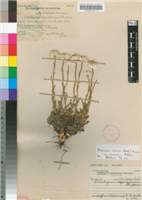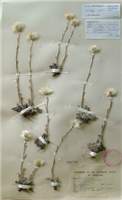Origin of name:
aureus / -a/ -um = golden
candindus / -a/ -um = pure white
Diagnostic characters:
Basal leaf rosettes
Large solitary heads
White bracts
Description:
Perennial herb, very variable in stature, in leaf-size and indumentum, and in head size, stock becoming very stout and woody, crown up to c. 25 mm diam. producing one or several leaf rosettes, flowering stems several, lateral to the rosettes, c. 100�400 (�800) mm high, simple or sparingly branched towards the top, branches simple, glandular-setose, often cobwebby or loosely white-woolly as well, leafy throughout. Radical leaves c. 30�100 (�270) x 10�25 (�60) mm, narrowly or broadly elliptic-spathulate, apex obtuse to subacute, base broad, clasping, both surfaces glandular-setose, lower or both surfaces sometimes woolly as well, sometimes wool confined to margins and midline; cauline leaves up to 70 x 20 mm, decreasing in size upwards, oblong, oblong-lanceolate to lanceolate upwards, correspondingly obtuse, acute to acuminate, apiculate, base more or less cordate-clasping, very shortly decurrent in the larger leaves, glandular-setose, sometimes cobwebby or loosely woolly as well, wool sometimes confined to margins or margins and main veins. Heads heterogamous, depressed-globose, 17�45 mm across the radiating bracts, solitary or up to c. 6 subracemosely or corymbosely arranged at the stem tip on long or short leafy peduncles. Involucral bracts in c. 7�9 series, graded, imbricate, much exceeding flowers, radiating, glossy, bright yellow, outer sometimes overlaid palest brown or buff, occasionally snow-white. Receptacle scarcely honeycombed. Flowers 311�1856, 34�284 female, 251�1671 homogamous, yellow. Achenes 0,75�1 mm long, barrel-shaped, glabrous. Pappus bristles many, equaling corolla, tips barbellate, bases with patent cilia not or scarcely cohering.
Flowering August to October.
Distribution:
Recorded from Pigg's Peak and Mbabane districts in Swaziland, Wakkerstroom district in Mpumalanga and the Utrecht, Paulpietersburg and Richmond districts in KwaZulu-Natal.
Grassland Biome.
Notes:
Six varieties are recognized:
la Involucral bracts yellow, outer sometimes pale brown or buff:
2a Heads mostly 15�20 mm long measured from base of outer involucral bracts to tips of longest inner ones, c. 35�45 mm across the fully radiating involucral bracts; if only 30 mm across, then on cliffs in the Drakensberg:
3a Flowering stems loosely woolly or cobwebby mostly throughout; flowering mainly between August and December:
4a Plants growing in grassland or scrub:
5a Cauline leaves only very lightly woolly, or wool confined to margins and midline
(a) var. aureum
5b Cauline leaves thickly and persistently silver-grey woolly
(f) var. argenteum
4b Plants growing on cliff faces or on rocky terrain immediately below cliffs in the Drakensberg
(b) var. scopulosum
3b Flowering stems woolly or cobwebby only in the uppermost part, flowering mainly between January and April
(c) var. serotinum
2b Heads mostly 8�15 mm long, up to 32 mm across the radiating bracts, growing in grassland
(d) var. monocephalum
1b Involucral bracts snow-white
(e) var. candidum
Compton 26990 and 28009 (NBG; PRE), from grassland near Forbes Reef, Swaziland, appear to be a variant with grey-woolly cauline leaves.
Sometimes mistaken for H. elegantissimum.
Differs from var. monocephalum in its snow-white bracts, and the two varieties may grow together.
Taxonomy:
Literature:
Helichrysum aureum (Houtt.) Merrill var. candidum Hilliard in Notes R. bot. Gdn Edinb. 34: 80 (1975), Compositae in Natal 254 (1977).
Type:
Swaziland, near Mbabane, Mhlambanyati, 1968, Cook s.n. (NU, holo.; mixed with var. monocephalum).
Synonym(s):
Vouchers:
Acocks 11745 (PRE); Codd 1728 (NU; PRE); Devenish 1563 (E; K; NU).


